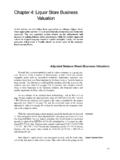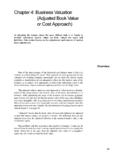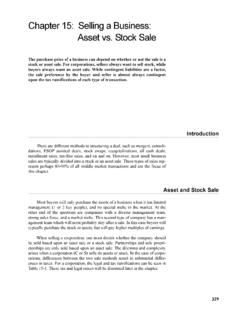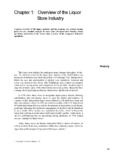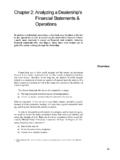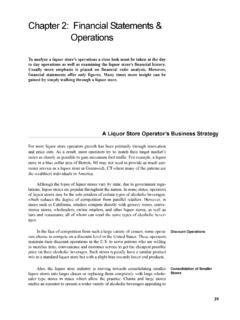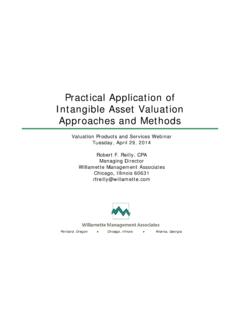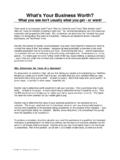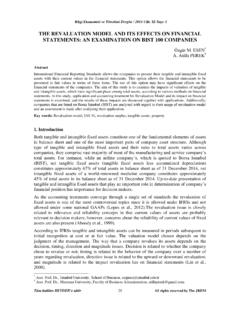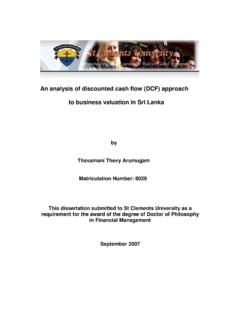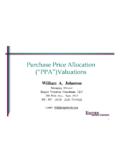Transcription of Chapter 4: Business Valuation: Auto/RV Dealerships
1 85 Chapter 4: Business valuation : Auto/RV DealershipsWhen valuing the Business , the most difficult task is adjusting the incomeand expense statements as well as the balance sheets of the operation. Thissection focuses on the adjustments and nuances of making theseadjustments, as well as the most typical techniques used to value a techniques have been simplified for the Balance Sheet ( Business valuation )Overall, this valuation method is used to value a company as a going con-cern. However, it has a number of shortcomings in that it does not considerintangible assets such as: an assembled workforce, trademarks, customer lists,technical know how, etc. Most importantly, if a buyer were to start the businessfrom scratch, then this buyer would probably purchase all of the assets at a liq-uidation value. In summary, this valuation methodology is most important to theinsurance industry and financial lenders, and usually represents the floor valueof a Business .
2 When the value indicated by the market and income approach isless than the adjusted balance sheet value, then the Business is probably not agoing concern. InventoriesInventories need to be adjusted to some degree. Most adjustments are madepursuant to IRS Revenue Procedure 77-12, which governs the treatment of man-ufacturing and retail , raw materials are valued at their most recent cost. If the inventory is acommodity, then it may be valued at its purchase cost. Second, work-in pro-cess inventory gets special treatment. It may be approached either from its cost(plus an allowance for the value that has been embedded by the manufacturer)or from its ultimate sale price. Third, the finished-goods inventory is typicallyvalued by determining the amount that will be received from its sale in the ordi-nary course of Business , less any normal discounts and allowances, less the costthat the new owner incurs in holding, transporting, and making the sale of theinventoried products, less any returns.
3 Finally, the buyer s share of the antici-pated profit should be adjusted. Business valuation : Auto/RV Dealerships86If the company is using the FIFO (first in, first out) method of inventory,then one may utilize the book value as a proxy for the fair value. If the companyis using the LIFO (last in, first out) method of inventory, then one must add theLIFO reserve to conclude at a rough approximation of the FIFO value. ThisTable 4-1: Sample Adjusted Balance Sheet Book ValueAdjustmentMarketVa l u eAssetsCash & Equivalents 1,278,553 1,278,553 Accounts Receivable210,153210,153 Inventory3,060,6051,625,0004,685,605 Other Assets198,0444,645202,689 Total Current Assets4,747,3551,629,6456,377,000 Fixed Assets Furniture83,552(50,000)33,552 Vehicles108,016(57,066)50,950 Machinery & Equipment173,003(100,000)73,003 Fixtures & Leasehold Improvements57,082(30,000)27,082 Total Fixed Assets421,653(237,066)184,587 Depreciation(355,000)355,000-Net Fixed Assets66,653117,934184,587 Other Assets461,627(385,000)76,627 Total Assets5,275,6351,362,5796,638,214 LiabilitiesCurrent LiabilitiesAccounts Payable$ 361,484$ 361,484 Accrued Liabilities223,850223,850 Notes Payable (Current)2,345,5412,345,541 Current Portion Long Term Debt--Other Current Liabilities133,350133,350 Total Current Liabilities3,064,2253,064,225 Long Term Debt Real Estate --Operations 40,00040,000 Total LTD (Real Estate + Operations)
4 40,00040,000 Note Payable-Stockholder-- Capital Lease Obligations--Total Liabilities3,104,2253,104,225 Stockholder s Equity2,171,4101,362,5793,533,989 Total Equity & Liabilities5,275,6351,362,5796,638,214 Business valuation : Auto/RV Dealerships87method is often used when valuing auto and truck Dealerships for the auto ortruck inventory as well as for RV dealers. Note that LIFO can understate thevalue of the existing inventory when the cost per unit is increasing over example of the extent to which LIFO can affect the value on a balance sheetcan be seen in Table 4-1. GoodwillWith the adjusted balance sheet method, goodwill should also be factoredin. Most companies sell for their adjusted book value plus a premium of zero totwo times EBITDA. For our subject company, this would result in a premium(goodwill value) of the EBITDA of $868,771 multiplied by two, to equal anadditional $1,737,542 of value. Total invested capital would equal $7,657,072and after subtracting out the $2,385,541 of interest bearing debt, the equityvalue would be $5,271,531.
5 As an example of an adjusted book methodology, look at Table 4-1 andcompare the adjusted book value to the values concluded by the marketapproach (see Table 4-10 on page 93 and Table 4-11 on page 94), and the con-cluded value of the income approach in Table 4-14 on page 97. It must be notedthat not all companies indicate such a range in values. A summary of all of theconcluded values can be seen in Table 4-16 on page 4-1: Example of auto Dealership Relative to LIFO ReserveLine ItemAmountExisting Net Book Value$3,060,605 LIFO Reserve1,625,000 Adjusted Net Book Value$4,685,605 Table 4-2: Concluded Values (Adjusted Balance Sheet)Line ItemAmountAdjusted Equity Value$3,533,989 Plus: LTD (Long Term Debt)$40,000 Plus: Notes Payable$2,345,541 Total Invested Capital (not including Goodwill)$5,919,530 Plus: Goodwill$1,737,542 Total Invested Capital (including Goodwill)$7,657,072 Less: LTD & Current Portion(2,385,541)Equity Value (including Goodwill)$5,271,531 Business valuation : Auto/RV Dealerships88 Market Approach (Guideline Company Approach)Before applying the market multiples we need to adjust the cash flow of thesubject dealership, striping out the value of the real estate so as to provide aleasehold value of the Business .
6 This would allow us to compare apples withapples when comparing our subject dealership with the other public companydealerships that operate predominately under of Cash FlowTable 4-3 shows a summary of the adjustments needed to be made to thecash flows, which are taken from the example in Table 2-5 on page 53 of oursubject dealership. As can be seen from the table above, we need to adjust the cash flow forthe fair market rent of the real estate. We used a capitalization rate to calculatemarket rent of our subject dealership. A full real estate valuation was completedTable 4-3: Adjustments to the Income Statement of Subject Dealership 20072006 Income Before Taxes*$833,034$775,996 Depreciation & Amortization (Equip)18,21622,839 Interest Expense (Operations)*17,5211,000 Unadjusted EBITDA868,771799,835 Plus: Discretionary Expenses125,000125,000 Plus: Actual Rent Paid400,000400,000 Less: Fair Market Rent**(480,000)(480,000)Adjusted EBITDA (leasehold cash flow)$913,771$844,835 Unadjusted Cash Flow$932,196$878,800 Plus: Discretionary Expenses125,000125,000 Plus: Actual Rent Paid400,000400,000 Less: Fair Market Rent**(480,000)(480,000)Adjusted Cash Flow (leasehold cash flow))$977,196$923,800 Unadjusted EBITDA$868,771$799,835 Plus: Discretionary Expenses125,000125,000 Plus: Actual Rent Paid400,000400,000 Adjusted EBITDA (fee simple cash flow)$1,393,771$1,324,835 Unadjusted Cash Flow$932,196$878,800 Plus: Discretionary Expenses125,000125,000 Plus.
7 Actual Rent400,000400,000 Adjusted Cash Flow (fee simple)$1,457,196$1,403,800* Figures are taken from the balance sheet and income statements found in Table 2-4 on page 52 and Table 2-5on page 53 (2007 EBT= $850,555 EBIT - $17,251 interest expense).** Fair Mkt Rent = RE Value (6,000,000) x Capitalization Rate ( ) = $480,000. The value of $6,000,000includes two valuation : Auto/RV Dealerships89in Asset valuation For RV and auto Dealerships (Real Estate) on page dealership owns two locations. One of the locations was purchased 12months prior from the lessor (seller) for $2,560,000. The second was appraisedfor a concluded value of $3,440,000 as shown on page 116. For this reason, the$6,000,000 real estate value is a total of $2,560,000 and $3,440, Traded InformationUsing publicly traded information and comparing this to our sample com-pany, whose balance sheet and income statements are in Table 2-4 on page 52,and in Table 2-5 on page 53, shown earlier, we can contrast differences betweenthe subject company and the market comparables.
8 The subject company is anew and used car dealership company with several locations. It must be notedthat the comparables have not been adjusted for items such as differences ininventory practices, intangible assets or off balance sheet financing, deprecia-tion or capital structure. Table 4-7 shows the breakdown of the various components of the companywhich make up the returns on equity (ROE), based upon a DuPont analysis. Thereader will recall that this overview is critical for understanding which compo-nent drives the equity return. These ratios are more fully described earlier -See DuPont Model on page 60. Table 4-4: Comparative Ratios as a Percentage of Assets & Income (Unadjusted) ($000 s)SubjectCompany 1(AutoNation)Company 2(PenskeAutomotiveGroup)Company 3(LithiaMotors)Company 4(CarMax)Company 5(Group 1 Automotive)Company 6(SonicAutomotive)MedianComparableBalanc e SheetTotal Assets (%)100%100%100%100%100%100%100%Cash & Fixed Term Assets ($000)$5, $8,607,000$4,469,8021,579,357$1,885,573$ 2,113,955$3,124,764$2,619,360 Income StatementRevenue (%)Working Working ($000)$26,265$18,989,000$11,242,313$3,17 2,894$7,465,656$6,083,484$7,972,074$7,71 8,865 Source.
